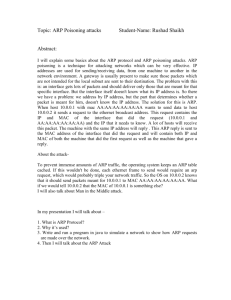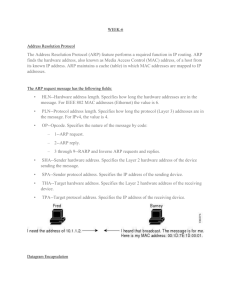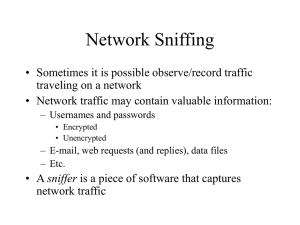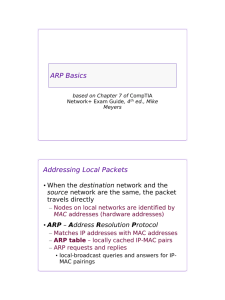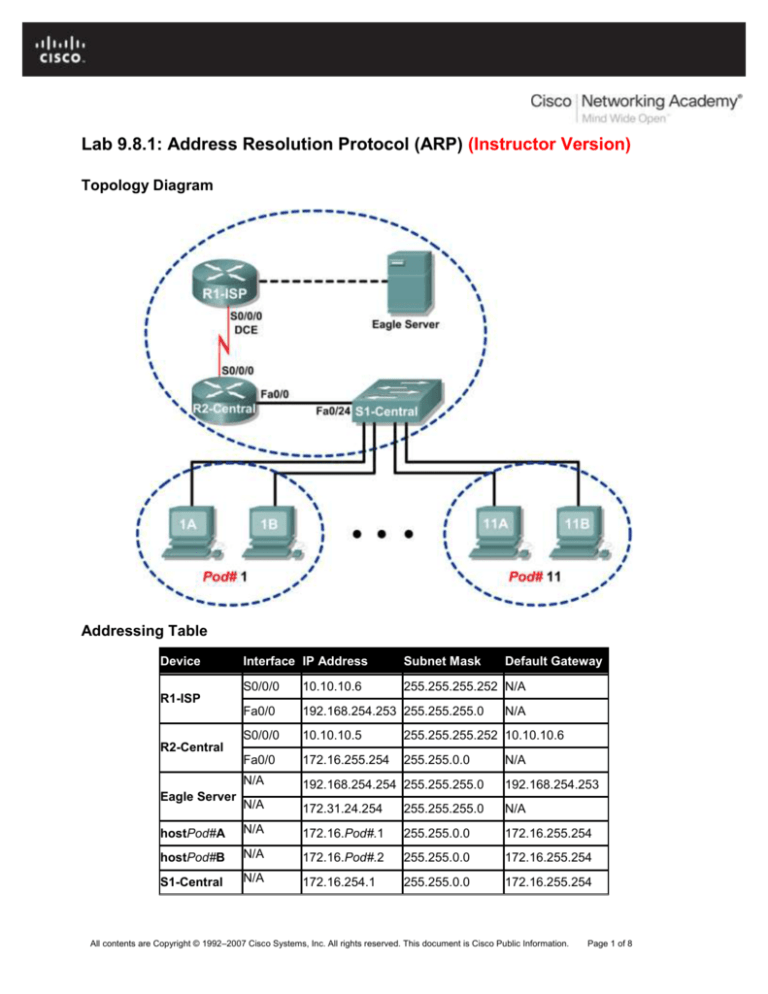
Lab 9.8.1: Address Resolution Protocol (ARP) (Instructor Version)
Topology Diagram
Addressing Table
Device
Interface IP Address
Subnet Mask
Default Gateway
S0/0/0
10.10.10.6
255.255.255.252 N/A
Fa0/0
192.168.254.253 255.255.255.0
S0/0/0
10.10.10.5
255.255.255.252 10.10.10.6
Fa0/0
172.16.255.254
255.255.0.0
N/A
192.168.254.254 255.255.255.0
192.168.254.253
N/A
172.31.24.254
255.255.255.0
N/A
hostPod#A
N/A
172.16.Pod#.1
255.255.0.0
172.16.255.254
hostPod#B
N/A
172.16.Pod#.2
255.255.0.0
172.16.255.254
S1-Central
N/A
172.16.254.1
255.255.0.0
172.16.255.254
R1-ISP
N/A
R2-Central
Eagle Server
N/A
All contents are Copyright © 1992–2007 Cisco Systems, Inc. All rights reserved. This document is Cisco Public Information.
Page 1 of 8
CCNA Exploration
Network Fundamentals: Ethernet
Lab 9.8.1: Address Resolution Protocol (ARP)
Learning Objectives
Upon completion of this lab, you will be able to:
Use Windows arp command.
Use Wireshark to examine ARP exchanges.
Background
Address Resolution Protocol (ARP) is used by TCP/IP to map a Layer 3 IP address to a Layer 2 MAC
address. When a frame is placed on the network, it must have a destination MAC address. To
dynamically discover the MAC address to the destination device, an ARP request is broadcast on the
LAN. The device that contains the destination IP address responds, and the MAC address is recorded in
ARP cache. Every device on the LAN keeps its own ARP cache, or small area in RAM that holds ARP
results. An ARP cache timer removes ARP entries that have not been used for a certain period of time.
Depending on the device, times differ. For example, some Windows operating systems store ARP cache
entries for 2 minutes. If the entry is used again during that time, the ARP timer for that entry is extended
to 10 minutes.
ARP is an excellent example in performance tradeoff. With no cache, ARP must continually request
address translations each time a frame is placed on the network. This adds latency to the communication
and could congest the LAN. Conversely, unlimited hold times could cause errors with devices that leave
the network or change the Layer 3 address.
A network engineer needs to be aware of ARP but may not interact with the protocol on a regular basis.
ARP is a protocol that enables network devices to communicate with the TCP/IP protocol. Without ARP,
there is no efficient method to build the datagram Layer 2 destination address. Also, ARP is a potential
security risk. ARP spoofing, or ARP poisoning, is a technique used by an attacker to inject the wrong
MAC address association in a network. An attacker forges the MAC address of a device, and frames are
sent to the wrong destination. Manually configuring static ARP associations is one way to prevent ARP
spoofing. Finally, an authorized MAC address list may be configured Cisco devices to restrict network
access to only approved devices.
Scenario
With a pod host computer, use the Windows arp utility command to examine and change ARP cache
entries.
In Task 2, Wireshark will be used to capture and analyze ARP exchanges between network devices. If
Wireshark has not been loaded on the host pod computer, it can be downloaded from URL
ftp://eagle-server.example.com/pub/eagle_labs/eagle1/chapter9/, file wiresharksetup-0.99.4.exe.
Depending on the classroom situation, the lab topology may have been modified before this class. It is
best to use one host to verify infrastructure connectivity. If the default web page cannot be accessed from
eagle-server.example.com, troubleshoot end-to-end network connectivity:
1. Verify that all network equipment is powered on, and eagle-server is on.
2. From a known good host computer, ping eagle-server. If the ping test fails, ping S1-Central, R2Central, R1-ISP, and finally eagle-server. Take corrective action on devices that fail ping tests.
3. If an individual host computer cannot connect to eagle-server, check the cable connection
between the host and S1-Central. Verify that the host computer has the correct IP address,
shown in the logical addressing table above, and can ping R2-Central, 172.16.255.254. Verify
that the host computer has the correct Gateway IP address, 172.16.255.254, and can ping R1ISP, 10.10.10.6. Finally, verify that the host has the correct DNS address, and can ping eagleserver.example.com.
All contents are Copyright © 1992–2007 Cisco Systems, Inc. All rights reserved. This document is Cisco Public Information.
Page 2 of 8
CCNA Exploration
Network Fundamentals: Ethernet
Lab 9.8.1: Address Resolution Protocol (ARP)
Task 1: Use the Windows arp Command.
Step 1: Access the Windows terminal.
C:\> arp
Displays and modifies the IP-to-Physical address translation tables
used by address resolution protocol (ARP).
ARP -s inet_addr eth_addr [if_addr]
ARP -d inet_addr [if_addr]
ARP -a [inet_addr] [-N if_addr]
-a
Displays current ARP entries by interrogating the current
protocol data. If inet_addr is specified, the IP and
Physical addresses for only the specified computer are
displayed. If more than one network interface uses ARP,
entries for each ARP table are displayed.
-g
Same as -a.
inet_addr
Specifies an internet address.
-N if_addr Displays the ARP entries for the network interface
specified by if_addr.
-d
Deletes the host specified by inet_addr. inet_addr may be
wildcarded with * to delete all hosts.
-s
Adds the host and associates the Internet address inet_addr
with the Physical address eth_addr. The Physical address
is given as 6 hexadecimal bytes separated by hyphens. The
entry is permanent.
eth_addr
Specifies a physical address.
if_addr
If present, this specifies the Internet address of the
interface whose address translation table should be
modified. If not present, the first applicable interface
will be used.
Example:
> arp -s 157.55.85.212 00-aa-00-62-c6-09 .... Adds a static entry.
> arp -a
.... Displays the arp table.
C:\>
Figure 1. arp Command Syntax
1. Open a Windows terminal by clicking Start > Run. Type cmd, and click OK.
With no options, the arp command will display useful help information. See Figure 1.
2. Issue the arp command on the pod host computer, and examine the output.
3. Answer the following questions about the arp command:
What command would be used to display all entries in ARP cache?
________arp -a_________________________
What command would be used to delete all ARP cache entries (flush ARP cache)?
________ arp –d *________________________
What command would be used to delete the ARP cache entry for 172.16.255.254?
_____ arp –d 172.16.255.254______________
All contents are Copyright © 1992–2007 Cisco Systems, Inc. All rights reserved. This document is Cisco Public Information.
Page 3 of 8
CCNA Exploration
Network Fundamentals: Ethernet
Lab 9.8.1: Address Resolution Protocol (ARP)
Step 2: Use the arp command to examine local ARP cache.
C:\> arp -a
No ARP Entries Found
C:\>
Figure 2. Empty ARP Cache
Without any network communication, the ARP cache should be empty. This is shown in Figure 2.
Issue the command that displays ARP entries. What are the results?
____________________________________________________________________________________
____________________________________________________________________________________
ARP cache should be empty. Any entry indicates communication between the pod host computer and
other network devices.
Step 3: Use the ping command to dynamically add entries in the ARP cache.
The ping command can be used to test network connectivity. By accessing other devices, ARP
associations are dynamically added to ARP cache.
C:\> ping 172.16.1.2
Pinging 172.16.1.2 with 32 bytes of data:
Reply from 172.16.1.2: bytes=32 time<1ms TTL=128
Reply from 172.16.1.2: bytes=32 time<1ms TTL=128
Reply from 172.16.1.2: bytes=32 time<1ms TTL=128
Reply from 172.16.1.2: bytes=32 time<1ms TTL=128
Ping statistics for 172.16.1.2:
Packets: Sent = 4, Received = 4, Lost = 0 (0% loss),
Approximate round trip times in milli-seconds:
Minimum = 0ms, Maximum = 0ms, Average = 0ms
C:\>
Figure 3. ping Command to a Pod Host Computer
1. Use the command ipconfig /all to verify the pod host computer’s Layer 2 and Layer 3
information.
2. Issue the ping command to another pod host computer, shown in Figure 3. Figure 4 shows the
new ARP cache entry.
C:\> arp -a
Interface: 172.16.1.1 --- 0x60004
Internet Address
Physical Address
172.16.1.2
00-10-a4-7b-01-5f
C:\>
Type
dynamic
Figure 4. Display of ARP Cache
How was the ARP entry added to the ARP cache? Hint: review the Type column.
___Dynamic___________________
What is the physical address of the destination pod host computer?
___Answers will vary.___________
All contents are Copyright © 1992–2007 Cisco Systems, Inc. All rights reserved. This document is Cisco Public Information.
Page 4 of 8
CCNA Exploration
Network Fundamentals: Ethernet
Lab 9.8.1: Address Resolution Protocol (ARP)
What is the physical address of the destination pod host computer?
IP Address
Physical Address
How Discovered?
Answers will vary.
Answers will vary.
Dynamic
3. Do not send any traffic to the computer accessed previously. Wait between 2 and 3 minutes, and
check ARP cache again. Was the ARP cache entry cleared? __________ Yes. If the entry was
not cleared, there are a couple possible explanations. First, the student did not wait 2 minutes,
which is the time ARP cache stores an initial entry. Or, the student accessed the destination
device more than once during the 2-minute timeout window, and caused the ARP timeout for the
entry to rise to 10 minutes.
4. Issue the ping command to the Gateway, R2-Central. Examine ARP cache entry. What is the
physical address of the Gateway? ________________________________________
IP Address
Physical Address
How Discovered?
172.16.255.254
Answers will vary.
Dynamic
5. Issue the ping command to Eagle Server, eagle-server.example.com. Examine ARP cache
entry. What is the physical address of Eagle Server? ___________________________________
_____________________________________________________________________________
_____________________________________________________________________________
Cannot be determined. Because Eagle Server is on a different network, only the Gateway MAC
address will be displayed.
Step 4: Manually adjust entries in the ARP cache.
To delete entries in ARP cache, issue the command arp –d {inet-addr | *}. Addresses can be
deleted individually by specifying the IP address, or all entries can be deleted with the wildcard *.
Verify that the ARP cache contains two entries: one for the Gateway and one to the destination pod host
computer. It may be easier to ping both devices more than once, which will retain the cache entry for
approximately 10 minutes.
C:\> arp –a
Interface: 172.16.1.1 --- 0x60004
Internet Address
Physical Address
172.16.1.2
00-10-a4-7b-01-5f
172.16.255.254
00-0c-85-cf-66-40
C:\>
C:\>arp -d 172.16.255.254
C:\> arp -a
Interface: 172.16.1.1 --- 0x60004
Internet Address
Physical Address
172.16.1.2
00-10-a4-7b-01-5f
C:\>
Type
dynamic
dynamic
Type
dynamic
Figure 5. Manually Removing an ARP Cache Entry
See Figure 5, which shows how to manually delete an ARP cache entry.
1. On your computer, first verify that the two entries are present. If not, ping the missing entry.
2. Next, delete the entry for the pod host computer.
3. Finally, verify your change.
All contents are Copyright © 1992–2007 Cisco Systems, Inc. All rights reserved. This document is Cisco Public Information.
Page 5 of 8
CCNA Exploration
Network Fundamentals: Ethernet
Lab 9.8.1: Address Resolution Protocol (ARP)
4. Record the two ARP cache entries:
Device
IP Address
Physical Address
How Discovered?
Pod Host
Computer
Answers will vary.
Answers will vary.
Dynamic
Gateway
172.16.255.254
Answers will vary.
Dynamic
5. Write the command that will delete the entry for the pod host computer:
____ arp –d inet-addr _______________
6. Issue the command on your pod host computer. Record the remaining ARP cache entry:
Device
IP Address
Physical Address
How Discovered?
Gateway
172.16.255.254
Answers will vary.
Dynamic
7. Simulate removing all entries. Write the command that will delete all entries in ARP cache:
___ arp –d *________________________
8. Issue the command on your pod host computer, and examine the ARP cache with the command
arp -a. All entries should be removed. __ No ARP Entries Found _________
9. Consider a secure environment where the Gateway controls access to a web server that contains
Top Secret information. What is one layer of security that can be applied to ARP cache entries
that could aid in countering ARP spoofing? __ Add a static ARP entry for the Gateway.______
10. Write the command that will add a static ARP entry for the Gateway to ARP cache:
___ arp –s 172.16.255.254 MAC-address _________
11. Examine the ARP cache again, and fill in the following table:
IP Address
Physical Address
Type
172.16.255.254
Answers will vary.
Static
For the next task, Wireshark will be used to capture and examine an ARP exchange. Do not close the
Windows terminal—it will be used to view the ARP cache.
Task 2: Use Wireshark to Examine ARP Exchanges .
Step 1: Configure Wireshark for packet captures.
Prepare Wireshark for captures.
1. Click Capture > Options.
2. Select the Interface that corresponds to the LAN.
3. Check the box to Update list of packets in real time.
4. Click Start.
This will begin the packet capture.
Step 2: Prepare the pod host computer for ARP captures.
1. If not already completed, open a Windows terminal window by clicking Start > Run. Type cmd,
and click OK.
2. Flush the ARP cache, which will require ARP to rediscover address maps. Write the command
that you used: _____ arp –d *_______________
All contents are Copyright © 1992–2007 Cisco Systems, Inc. All rights reserved. This document is Cisco Public Information.
Page 6 of 8
CCNA Exploration
Network Fundamentals: Ethernet
Lab 9.8.1: Address Resolution Protocol (ARP)
Step 3: Capture and evaluate ARP communication.
In this step, one ping request will be sent to the Gateway, and one ping request will be sent to Eagle
Server. Afterward, Wireshark capture will be stopped and the ARP communication evaluated.
1. Send one ping request to the Gateway, using the command ping –n 1 172.16.255.254.
2. Send one ping request to Eagle Server, using the command ping –n 1 192.168.254.254.
Figure 6. Wireshark Capture of ARP Communication
3. Stop Wireshark and evaluate the communication. You should see a Wireshark screen similar to
the screen shown in Figure 6. The Wireshark Packet list window displays the number of packets
captured. The Packet Details Window shows ARP protocol contents.
4. Using your Wireshark capture, answer the following questions:
What was the first ARP packet? _____a Request________________
What was the second ARP packet? __a Reply____________________________
Fill in the following table with information about the first ARP packet:
Field
Sender MAC address
Sender IP address
Target MAC address
Target IP address
Value
Answers will vary
Answers will vary
00:00:00:00:00:00
172.16.255.254
Fill in the following table with information about the second ARP packet:
Field
Sender MAC address
Sender IP address
Target MAC address
Target IP address
Value
Answers will vary
172.16.255.254
Answers will vary
Answers will vary
All contents are Copyright © 1992–2007 Cisco Systems, Inc. All rights reserved. This document is Cisco Public Information.
Page 7 of 8
CCNA Exploration
Network Fundamentals: Ethernet
Lab 9.8.1: Address Resolution Protocol (ARP)
If the Ethernet II frame for an ARP request is a broadcast, why does the Target MAC address
contain all 0s? ____ The ARP protocol has no value yet to put in the field.__________________
Why was there no ARP request for the ping to Eagle Server? ____________________________
_____________________________________________________________________________
_____________________________________________________________________________
The TCP/IP protocol already had the MAC address for the Gateway, which is used to forward the
packet outside the LAN.
How long should the Gateway mapping be stored in ARP cache on the pod host computer? Why?
_____________________________________________________________________________
_____________________________________________________________________________
10 minutes, because the cache entry was accessed within the 2-minute cache timeout. This set
the new timeout value to 10 minutes.
Task 3: Reflection
The ARP protocol maps Layer 3 IP addresses to Layer 2 MAC addresses. If a packet must move across
networks, the Layer 2 MAC address changes with each hop across a router, but the Layer 3 address
never changes.
ARP cache stores ARP address mappings. If the entry was learned dynamically, it will eventually be
deleted from cache. If the entry was manually inserted in ARP cache, it is a static entry and will remain
until the computer is turned off or the ARP cache is manually flushed.
Task 4: Challenge
Using outside resources, perform a search on ARP spoofing. Discuss several techniques used to counter
this type of attack.
Most wireless routers support wireless network access. Using this technique, MAC addresses that are
permitted access to the wireless network are manually added to the wireless router. Using outside
resources, discuss the advantages of configuring wireless network access. Discuss ways that attackers
can circumvent this security.
Task 5: Clean Up
Wireshark was installed on the pod host computer. If Wireshark needs to be uninstalled, click Start >
Control Panel. Open Add or Remove Programs. Highlight Wireshark, and click Remove.
Remove any files created on the pod host computer during the lab.
Unless directed otherwise by the instructor, turn off power to the host computers. Remove anything that
was brought into the lab, and leave the room ready for the next class.
All contents are Copyright © 1992–2007 Cisco Systems, Inc. All rights reserved. This document is Cisco Public Information.
Page 8 of 8



